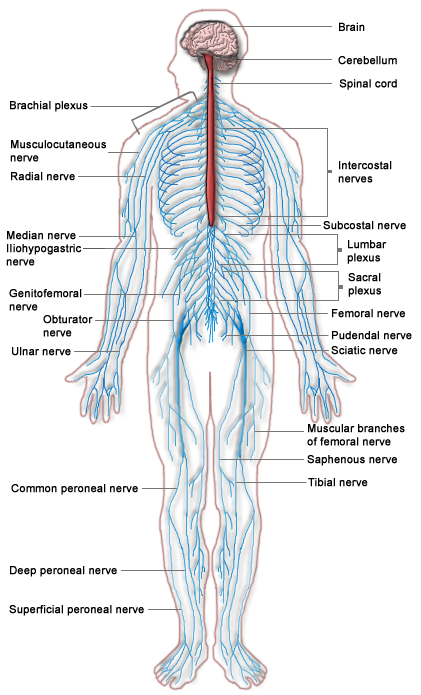14.1A: Comparing the Somatic and Autonomic Nervous Systems
- Page ID
- 7718
The peripheral nervous system includes both a voluntary, somatic branch and an involuntary branch that regulates visceral functions.
- Identify the differences between the somatic and autonomic nervous systems
Key Points
- The somatic nervous system (SoNS) is the part of the peripheral nervous system associated with the voluntary control of body movements through the skeletal muscles and mediation of involuntary reflex arcs.
- The autonomic nervous system (ANS) is the part of the peripheral nervous system that controls visceral functions that occur below the level of consciousness.
- The ANS can be subdivided into the parasympathetic nervous system (PSNS) and the sympathetic nervous system (SNS).
Key Terms
- peripheral nervous system: Consists of the nerves and ganglia outside of the brain and spinal cord.
- autonomic: Acting or occurring involuntarily, without conscious control.
- somatic nervous system: The part of the peripheral nervous system that transmits signals from the central nervous system to skeletal muscles, and from receptors of external stimuli, thereby mediating sight, hearing, and touch.
EXAMPLES
Examples of body processes controlled by the ANS include heart rate, digestion, respiratory rate, salivation, perspiration, pupillary dilation, urination, and sexual arousal.
The peripheral nervous system (PNS) is divided into the somatic nervous system and the autonomic nervous system. The somatic nervous system (SoNS) is the part of the peripheral nervous system associated with the voluntary control of body movements via skeletal muscles.
The SoNS consists of efferent nerves responsible for stimulating muscle contraction, including all the non-sensory neurons connected with skeletal muscles and skin. The somatic nervous system controls all voluntary muscular systems within the body, and also mediates involuntary reflex arcs. The somatic nervous system consists of three parts:

The human nervous system: The major organs and nerves of the human nervous system.
- Spinal nerves are peripheral nerves that carry motor commands and sensory information into the spinal cord.
- Cranial nerves are the nerve fibers that carry information into and out of the brain stem. They include information related to smell, vision, eyes, eye muscles, the mouth, taste, ears, the neck, shoulders, and the tongue.
- Association nerves integrate sensory input and motor output; these nerves number in the thousands.
The autonomic nervous system (ANS) is the part of the peripheral nervous system that acts as a control system, functioning largely below the level of consciousness and controlling visceral functions. The ANS affects heart rate, digestion, respiratory rate, salivation, perspiration, pupillary dilation, micturition (urination), and sexual arousal.
Whereas most of its actions are involuntary, some, such as breathing, work in tandem with the conscious mind. The ANS is classically divided into two subsystems: the parasympathetic nervous system (PSNS) and sympathetic nervous system (SNS).
The enteric nervous system is sometimes considered part of the autonomic nervous system, and sometimes considered an independent system.

